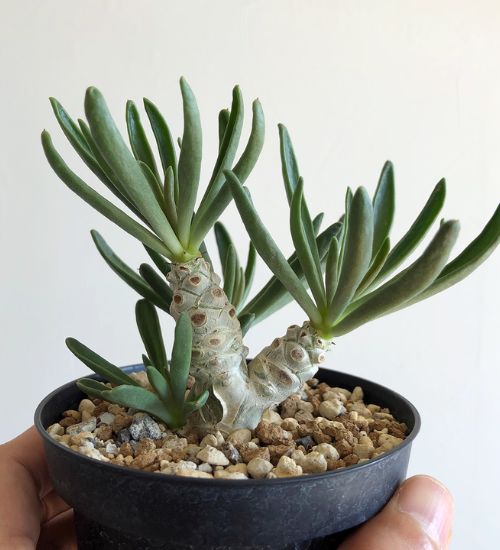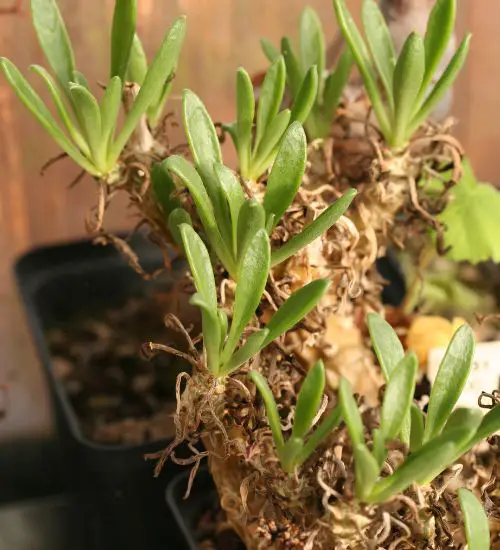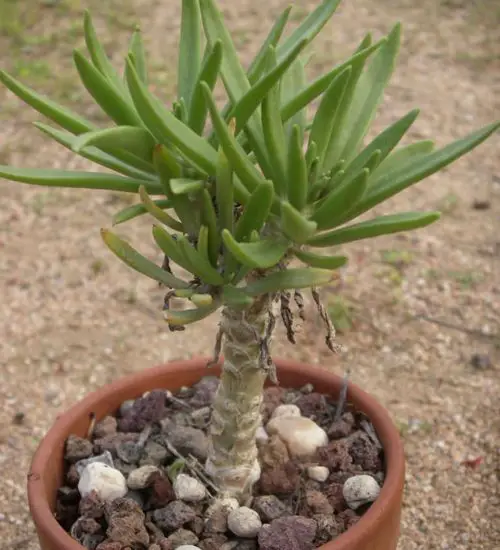Sun: Full sun to partial sun
Water: Typical water needs for a succulent
Temperature: Zone 10a from 30° F to 35° F (-1.1 ° C to 1.7° C) to Zone 11b from 45° F to 50° F (7.2° C to 10° C)
Winter Survival: Not cold hardy
Propagation: cuttings, seeds
Flower: at the end of summer
Flower Type: Red-Orange
Toxic: Toxic to humans and animals
Dormant: summer
Space Requirement: Indoors & Outdoors
Common Problems: Plants may rot if overwatered
Where to buy Tylecodon Grandiflorus?
Basc Care for Tylecodon Grandiflorus
Watering
What you need to remember is that this type of succulents needs to be watered for every 2 weeks
One simple tip for you is that you can use some online apps to check the soil status before you go water your succulents. I would recommend the ThePlantsCheck app, it has some nice features there.
Fertilizing
Only feed this succulent during its active growing seasons which means winter. Use the right fertilizer applied in the right amounts. Applying half-strength balanced fertilizer every month or so is recommended for optimal results.
Do not fertilize during summer as the plant is dormant.
Sun & Location Requirements for "Dwarf Butter Tree"
Tylecodon Grandiflorus loves the sun! To ensure your succulent is getting enough light, place it in a bright spot that receives direct sunlight for at least 6 hours each day. If you live in a cooler climate, consider bringing your succulent outside during the summer months.
As per this succulent profile, it is only able to stay healthy when the environment temperature is above the range of zone 10a from 30° F to 35° F (-1.1 ° C to 1.7° C).
When temperatures drop below freezing, it is important to take precautions to protect Tylecodon Grandiflorus from the cold. Insulating and providing adequate drainage for the plant are key elements in helping it survive winter weather. Wind and sun exposure should also be minimized to prevent frost damage.
Any succulents in the group will need a medium space to grow. You can place your pot at your table or window. Since this plant needs more space than mini succulents, you should consider do not plant them together with other succulents/plants.
Propagation
One way to propagate Tylecodon Grandiflorus is by cutting
Growing Tylecodon Grandiflorus from seeds is an easy and economical way to produce more plants. Identify a healthy seed by its plumpness, dark color and slightly sticky texture. Once the potting mix has been pre-mixed with well-draining soil, sow the seeds evenly and press lightly into the surface. To ensure germination, keep the container in bright but indirect light and mist the soil gently with a spray bottle.
Toxicity

Tylecodon Grandiflorus is a highly toxic plant and should be handled with extreme caution. Ingestion can cause nausea, vomiting and other serious health issues in both humans and animals alike.


